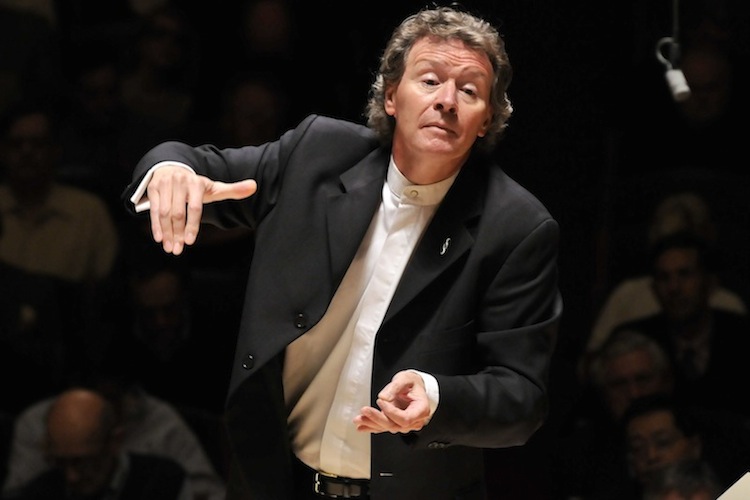Handel and Haydn opens season with a wide-ranging Bach feast

Harry Christophers conducted the Handel and Haydn’s Society’s season-opening concert Friday night at Symphony Hall. File photo: Stu Rosner
Bach’s music makes for a grand celebration. That was certainly the case Friday night at Symphony Hall, where Harry Christophers and the Handel and Haydn Society rang in the new season with music by the German master.
The works on the program, which featured cantatas, motets, and the beautiful Magnificat in D, shared stylistic connections with the music of Heinrich Schütz, a composer who lived and worked decades before Bach’s birth.
Schütz brought an intricate polychoral style to Dresden from Venice, where he had studied with the innovative Giovanni Gabrieli. Much of his music found its way to the St. Michael’s church school in Lüneburg, where a young Bach likely encountered it while a student.
Schütz’s work has all of the power and drama one encounters in Bach’s choral music. The elder composer’s motet Herr, nun lässest du deinen Diener, heard Friday night, is a marvel of texture. The music moves from chant-like phrases to resplendent passages.
Christophers led the H&H chorus with fine dramatic flair. The ensemble comprises some of the best singers in Boston, and the English conductor is an expert at shaping a vocal line. He guided soft phrases one moment and punched out a sudden forte in another.
Conductor and chorus explored the sweeter side of eighteenth-century choral repertoire in Bach’s motet Komm, Jesu, komm. This piece unfolds through two small, antiphonal choruses and a similar multi-sectional format found in Schütz’s work. Under Christophers’ direction, the lines of the piece lapped over one another like waves.
The multi-sectional structure also found its way into the cantatas, Bach’s most familiar and utilitarian works. In Cantata No. 149, Man singet mit Freuden von Sieg and Cantata No. 50,Nun ist das Heil und die Kraft, drama is paramount, with vibrant orchestral lines complementing the powerful choruses.
H&H’s performance of both works was elegant and lyrical. The soloists, drawn from the H&H chorus, sang with grace. David McFerrin floated the aria “Kraft und Stärke” from Cantata No. 149 with a rosy baritone that effectively mirrored the theme of strength as told in the text. Mezzo-soprano Catherine Hedberg and tenor Jonas Budris spun effervescent phrases around each other in the duet “Seid wachsam, ihr heiligen Wächter.” The highlight of this cantata was the aria for soprano, which tells of angels watching over the believer in all facets of life. Margot Rood, singing with warm radiant voice, brought the peaceful imagery to life.
Cantata No. 50 is a short, single-movement work that tells of the casting out of Lucifer from heaven. The chorus sang with rousing declamation, with the H&H period instrument orchestra lending sturdy support.
Bach’s Magnificat in D was the centerpiece of the evening. As is common with Bach’s grandest choral music, the work abounds with lyricism and blazing energy.
Here too, the performance beamed from the fine soloists. Soprano Sonja DuToit Tengblad sang “Et exultavit” with a rich vocal quality while adhering to Christophers’ quick tempo. Margot Rood found the poignant sorrow in “Quia respexit” while a solo oboe melody hung in the background like a weeping willow. Bass Woodrow Bynum sang “Quia fecit mihi magna” with a round, full voice, and tenor Stefan Reed found the righteous anger in his aria “Deposuit potentes.” The voices of Reed and mezzo-soprano Katherine Growdon blended softly for the sorrowful duet “Et misericordia.”
The chorus supplied the fire, singing with bristling power and precision in the weaving lines of the outer movements. The orchestra added jubilant sound, with fine contributions from flutists Christopher Krueger and Wendy Rolfe and trumpeters Timothy Will, Paul Perfetti, and Vincent Monaco.
Filling out the program was Bach’s Concerto for Three Violins.
The work is a scholarly reconstruction based upon the Concerto for Three Harpsichords, BWV 1064, and H&H concertmaster Aisslinn Nosky had a hand in bringing the piece to life. Like the original, the work possesses all of the hallmarks of Bach’s style. Streams and eddies of melody swirl about its tight-knit texture.
It’s a lovely and intriguing work with solo duties spread evenly between the evening’s featured violinists, Aisslinn Nosky, Christina Day Martinson, and Susanna Ogata. The outer movements had a buoyant quality as each soloist took turns with deft displays of sweeping and sawing figures. The second movement suffered from some unfocused intonation in the continuo, but the problem was quickly fixed, and the soloists arched elegant phrases in passing order. Ogata’s tone had a touch of amber, Martinson’s a lace of silver, while Nosky’s sound was bright and breathy.
The performance brought cheers and thunderous applause. And with that, H&H’s season was underway.
The program will be repeated 3 p.m. Sunday at Symphony Hall. handelandhaydn.org; 617-266-3605
Posted in Performances




